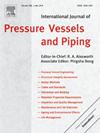VVER-1000反应堆压力容器基底和焊缝金属的辐射硬化和脆化
IF 3
2区 工程技术
Q2 ENGINEERING, MECHANICAL
International Journal of Pressure Vessels and Piping
Pub Date : 2025-04-11
DOI:10.1016/j.ijpvp.2025.105528
引用次数: 0
摘要
本文推导了ΔT0对ΔσY的理论依赖关系,并给出了VVER-1000反应堆压力容器母材和焊缝金属这些特性的实验数据。结果表明,在一般情况下,中子辐照引起的参考温度T0的偏移并不是辐射硬化的唯一函数。T0位移还取决于诸如参考温度T0下未辐照RPV金属屈服强度的热分量以及该分量在初始和辐照条件下的最大值等机械特性。同时,未辐照金属的参考温度T0的绝对值对金属的辐射硬化敏感性有决定性的影响。因此,这些特征之间的关系不能用线性函数来描述,就像今天所认为的那样。导出了一种分析依赖关系,在第一个近似中可以描述辐射硬化对参考温度移动的影响,并在此基础上解释这些数据在坐标“ ΔT0 - ΔσY”中显著分散的原因。得到了所研究的RPV金属的脆性强度Rc水平的实验数据。根据这些数据,焊缝金属的Rc值,在第一个近似上,不依赖于中子通量。在辐照的母材中观察到Rc有轻微下降的趋势。本文章由计算机程序翻译,如有差异,请以英文原文为准。
Radiation hardening and embrittlement of the base and weld metal of VVER-1000 reactor pressure vessels
In this paper the theoretical dependence of on was derived and experimental data for these characteristics for the base metal and weld metal of the VVER-1000 reactor pressure vessel (RPV) were given. It is shown that in the general case, the shift in the reference temperature due to neutron irradiation is not a unique function of radiation hardening. The shift also depends on such mechanical characteristics as the thermal component of yield strength for the unirradiated RPV metal at the reference temperature and the maximum values of this component in the initial and irradiated conditions. At the same time, the absolute value of the reference temperature of the unirradiated metal has a decisive influence on the sensitivity of the metal to radiation hardening. Therefore, the relationship between these characteristics cannot be described by a linear function, as is considered today. An analytical dependence has been derived, which allows, in the first approximation, to describe the influence of radiation hardening on the shift of the reference temperature and, on this basis, to explain the reasons for the significant scatter of these data in the coordinates " - ". Experimental data were obtained for the level of brittle strength for the RPV metal investigated. According to these data, the value of for the weld metal, to a first approximation, does not depend on the neutron fluence. A tendency to a slight decrease in is observed for the irradiated base metal.
求助全文
通过发布文献求助,成功后即可免费获取论文全文。
去求助
来源期刊
CiteScore
5.30
自引率
13.30%
发文量
208
审稿时长
17 months
期刊介绍:
Pressure vessel engineering technology is of importance in many branches of industry. This journal publishes the latest research results and related information on all its associated aspects, with particular emphasis on the structural integrity assessment, maintenance and life extension of pressurised process engineering plants.
The anticipated coverage of the International Journal of Pressure Vessels and Piping ranges from simple mass-produced pressure vessels to large custom-built vessels and tanks. Pressure vessels technology is a developing field, and contributions on the following topics will therefore be welcome:
• Pressure vessel engineering
• Structural integrity assessment
• Design methods
• Codes and standards
• Fabrication and welding
• Materials properties requirements
• Inspection and quality management
• Maintenance and life extension
• Ageing and environmental effects
• Life management
Of particular importance are papers covering aspects of significant practical application which could lead to major improvements in economy, reliability and useful life. While most accepted papers represent the results of original applied research, critical reviews of topical interest by world-leading experts will also appear from time to time.
International Journal of Pressure Vessels and Piping is indispensable reading for engineering professionals involved in the energy, petrochemicals, process plant, transport, aerospace and related industries; for manufacturers of pressure vessels and ancillary equipment; and for academics pursuing research in these areas.

 求助内容:
求助内容: 应助结果提醒方式:
应助结果提醒方式:


